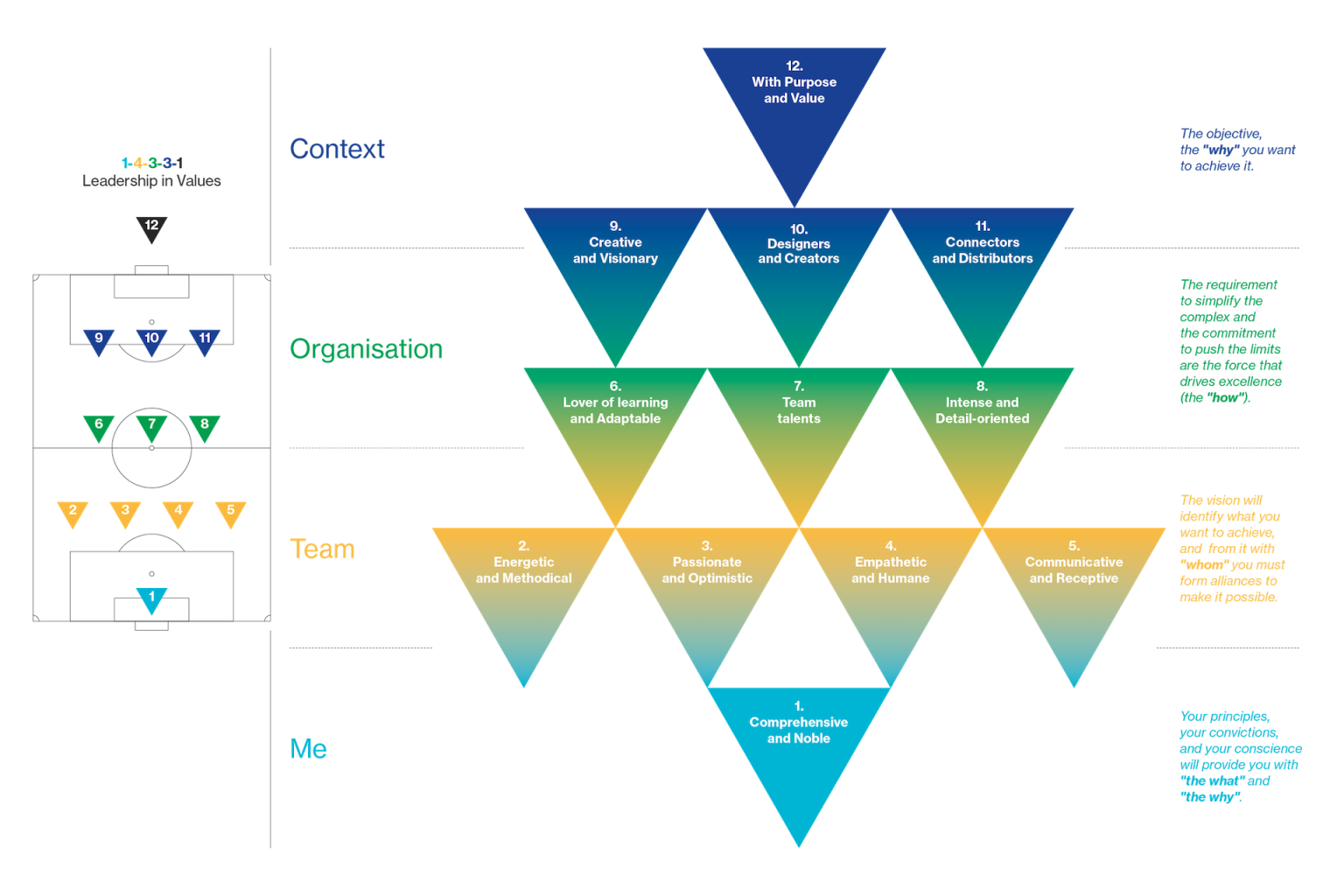A 4-3-3 alignment of values for an ethical leadership
The Leadership in Values Chair has developed its theoretical framework from different concepts linked to football.
The Leadership in Values Chair was created with the mission of generating, disseminating and transferring knowledge about values-based leadership and of fostering professional contexts of ethical practice related to people, their surroundings and the economy. This aspirational approach has been synthesised in a theoretical model that refers to the professional career of its directors: Pep Guardiola and Manel Estiarte and of the University Foundation, the institution behind the project. It is a project that has been developed within the framework of its academic management composed of Valentí Martínez, Òscar Dalmau, Albert Estiarte i Carlota Riera.
Values such as exemplarity, honesty, discipline, commitment, generosity, boldness, innovation, excellence and gratitude are organised in this theoretical model on an imaginary playing field in the form of a football line-up. Each one contains a seed of ethical leadership which can be interpreted as denoting different behaviours, attitudes and experiences which can be approached from an abstract to a specific perspective.
4-3-3 alignment
The 4-3-3 lineup is completed with a 1, the player-goalkeeper, and another 1, the twelfth player, the public When read horizontally, this alignment leads us to a model with four dimensions that invites us to reflect both from an organisational and a personal point of view. Thus, from the standpoint of the organisation, leadership is structured from oneself to one’s surroundings, passing through the team and the organisation. On the other hand, from a personal perspective, it invites us to think about the reasons which lay behind what one feels, what one says, thinks or does, and the relationships one establishes with others to finally question why one does what one actually does.
The arrangement of the values on the field also favours the identification of different intelligences linked to leadership: intrapersonal intelligence, which allows one to lead oneself through awareness; emotional intelligence, which transmits enthusiasm to the team and its contexts; linguistic intelligence, capable of mobilising people and teams with persuasion through words; interpersonal intelligence, which is often the key to the magnetism that some leaders command; and, finally, spiritual/existential intelligence, which leaves its mark on the surroundings because it is directly connected to a purpose that transcends individuals and the team and even the organisation itself.

Sport, Education, Health and Business
Leadership is an intrinsic part of any context in which different people work towards common or complementary goals. In addition to this, sport is undoubtedly a subject which generates passions and mobilises the masses. However, the chair aspires to make contributions in other areas in which the University Foundation of Bages, as the Manresa campus of the University of Vic – Central University of Catalonia, has a long and solid trajectory. Thus, the worlds of Business, Healthcare and Education are also other fields in which the Chair will make the ball roll, following the football metaphor of its conceptual model.
Twelve pairs of values
Values must be experienced and must be able to be translated into specific behaviour in specific situations. This is another of the contributions made by the conceptual model of the Leadership in Values Chair. The long trajectory of both directors and the transcendence of their actions and opinions are a source of inspiration to give entity and tangibility to the different values on which the chair builds its theoretical model.
1
Comprehensive and Noble.
Exemplarity and honesty are at the core of a leader’s moral authority and are directly linked to one’s principles and beliefs.
2
Energetic and Methodical.
Method is the sum of attitudes turned into habits. It includes discipline, perseverance and a culture of effort.
3
Passionate and Optimistic.
Enthusiasm, loving what you do, improves the result and also the process.
4
Empathetic and Humane.
The leader puts people first and therefore uses resources such as thanks and recognition. It is not about treating everyone equally but about treating everyone with an understanding of their individuality.
5
Communicative and Receptive.
The leader knows how to manage conflict through dialogue, which is why relational and communicative skills are essential. Emotional intelligence is also necessary in order to convert one’s own and other people’s feelings into words.
6
Lover of learning and Adaptable.
Good leadership requires a good understanding of each situation, of each challenge in order to adapt to them and give an adequate response. This skill requires flexibility and the ability to incorporate new ideas without giving up one’s own identity.
7
Team talents.
The team and its talents are what make it possible to achieve success: they must be developed and trusted.
8
Intense and Detail-oriented.
Planning and training make the future more predictable, without forgetting that in every process there is room for improvement, that there is always room for growth.
9
Creative and Visionary.
Far from being complacent, leaders constantly expose themselves to new challenges and drive their team to new limits. They are capable of providing a stimulating but attainable vision and sharing it.
10
Designers and Creators.
Style is what marks the difference between teams, so the leader is not only concerned with the result but also with the way it is achieved.
11
Connectors and Distributors.
Teams do not work in isolation, so the leader is a builder of bridges with their surroundings, seeking and establishing alliances.
12
With Purpose and Value.
The work of the team must be aligned with the objectives of the organisation, which, in the end, must seek to have a positive impact on its location, on people, on society and on the planet.
